A robust and healthy back is the backbone, quite literally, of a strong body and an active life. The back plays a pivotal role in almost every move we make, from standing up and walking around, to bending over to pick something up. When our backs are strong, these daily movements become easier and more efficient, improving our overall quality of life.
Back exercises are not only essential for athletes or those involved in heavy physical activities, but they are also crucial for everyone. Strengthening your back has numerous benefits. It can help improve your posture. Better posture will reduce the risk of back pain and injuries. A strong back also enhances your body balance and stability, aiding in the performance of other exercises and daily tasks.
Let’s embark on a journey together, exploring the significance of a robust back and diving into the top exercises that can ramp up your back strength. We’ll walk you through how to nail these exercises perfectly and share some handy tips to seamlessly weave them into your regular workout routine. Get ready to embark on a journey that will lead you to a healthier, stronger back and an overall improved physique.
The Importance of a Strong Back
Role of the Back in Daily Life and Physical Activities
Your back, often an unsung hero, plays a crucial role in your everyday activities. From picking up grocery bags to twisting to grab your seatbelt, your back muscles are constantly at work. In sports and fitness the back provides stability and strength for a wide range of motions. A strong, well-conditioned back ensures we can perform these tasks efficiently and without strain.
Connection between Back Strength and Overall Body Fitness
The strength of your back is intrinsically tied to your overall fitness. A robust back supports good posture, minimizes the risk of injuries, and enhances the efficiency of other workouts. It also helps in developing a balanced physique, as the back muscles are a part of many compound movements that engage multiple muscle groups simultaneously.
Understanding the Anatomy of the Back
The back is composed of various interconnected muscles, each with distinct roles. The ‘traps’ or trapezius muscles control the neck and shoulder movements. The latissimus dorsi, or ‘lats’, contribute to the ‘V-shape’ and are instrumental in pull movements. The rhomboids help retract the shoulder blades, and the erector spinae run along your spine, aiding in bending and twisting. Understanding the anatomy of your back aids in selecting effective exercises and performing them correctly.

Benefits of Back Exercises
How Back Exercises Contribute to Overall Body Strength
Back exercises are fundamental to increasing overall body strength. Since many back exercises are compound movements, they involve several joints and muscles groups at once. As a result, they don’t just strengthen your back, but also engage and tone other parts of your body, enhancing overall physical strength and capability.
Reduction of Chronic Back Pain
Engaging in regular back exercises can also be instrumental in reducing chronic back pain. Many back-related issues stem from weak, underutilized muscles. By strengthening these muscles, you can alleviate the strain on your back. This leads to less pain and discomfort over time.
Prevention of Back Injuries
A strong back is less prone to injury. Regularly performing back exercises helps to increase the flexibility and durability of your back muscles and your spine. making your back more resistant to stress and strain. This is especially beneficial for those who put a lot of pressure on their back through physical activities.
Improvement in Posture and Appearance
Back exercises are key to improving your posture, which can have a noticeable impact on your appearance and confidence. They help counteract the “hunched over” posture many of us develop from long hours sitting at a desk. An upright posture gives the impression of confidence and can also make you appear taller.
Contribution to Overall Athletic Performance
Finally, a strong back plays a critical role in overall athletic performance. It supports core stability and is crucial for virtually all types of athletic movements, from swinging a tennis racquet to tackling in football. Thus, strengthening your back can help to enhance performance in almost any sport or physical activity.

Best Practices for Performing Back Exercises
Correct Form and Posture
Maintaining proper form and posture is crucial when performing back exercises. This not only optimizes the effectiveness of each exercise but also reduces the risk of injuries. Engage your core, keep your back straight, and focus on controlled, deliberate movements. It’s also helpful to use a mirror or a trainer to ensure you’re executing each movement correctly.
The Importance of Warming Up Before Exercising
Warming up is an essential prelude to any workout, including back exercises. It increases body temperature, improves flexibility, and prepares your muscles for the workout ahead, reducing the risk of injury. A good warm-up could include light cardio, such as a brisk walk or jog, followed by dynamic stretching exercises specific to the back and related muscles.
Frequency and Duration of Training
The optimal frequency and duration of back exercises depend on your fitness goals, current fitness level, and overall training program. However, a general guideline is to target the back muscles at least twice per week. Each workout should include a variety of exercises that target the different muscles in the back. The sets and reps for these exercises should be adjusted according to your individual goals and progress.
The Role of Nutrition and Rest in Muscle Growth and Recovery
Nutrition and rest are as important as the workout itself. Consuming a balanced diet rich in protein aids in muscle recovery and growth. Additionally, getting adequate sleep and allowing time for rest and recovery between workouts is vital. It’s during these rest periods that your body repairs the muscle fibers. During this repair period is when increases in strength and muscle mass occur. Remember your back muscles are no different than any other muscle group. They need time to recover to grow stronger.
The 8 Best Back Exercises for a Rock Solid Back
1. Barbell Row
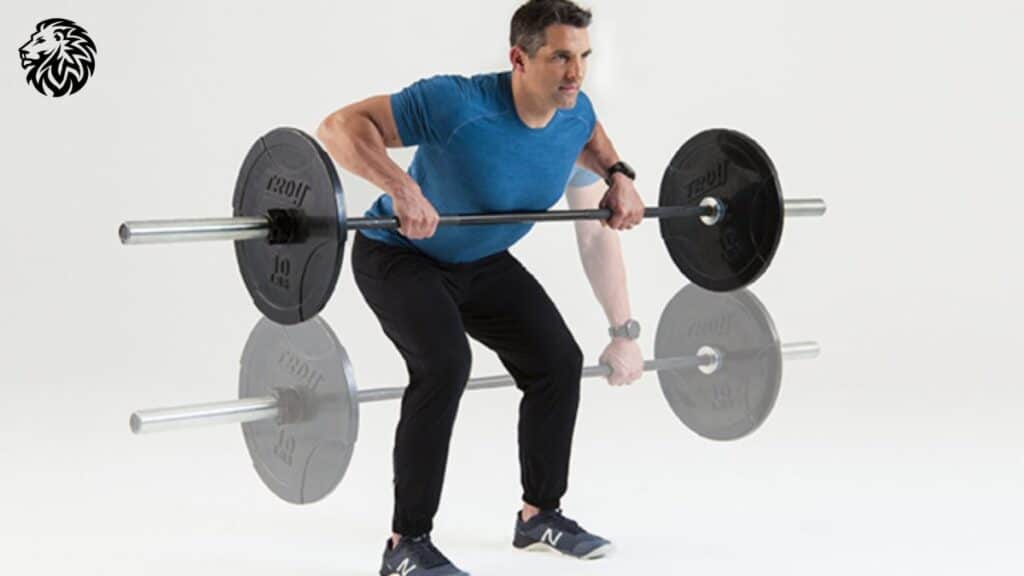
Description and Benefits:
The Barbell Row is a compound exercise that targets multiple back muscles, including the latissimus dorsi, rhomboids, and trapezius. This exercise also works the biceps and muscles in the shoulder and the lower back, making it a great choice for overall upper body strength. Regularly including barbell rows in your workout can improve both your posture and upper body strength.
Correct Form and Technique:
To perform a barbell row, stand with your feet hip-width apart, knees slightly bent. Hold the barbell with an overhand grip, hands just outside your legs. Bend at the hips, maintaining a straight back. Pull the barbell up towards your abdomen, squeezing your shoulder blades together at the top of the movement. Lower the barbell slowly and under control.
Common Mistakes to Avoid:
Some common mistakes include rounding the back, which can lead to injury, and pulling the barbell too high, which reduces the effectiveness of the exercise. Also, using momentum to lift, rather than controlled muscle strength, can compromise form and safety.
2. Pull-Ups
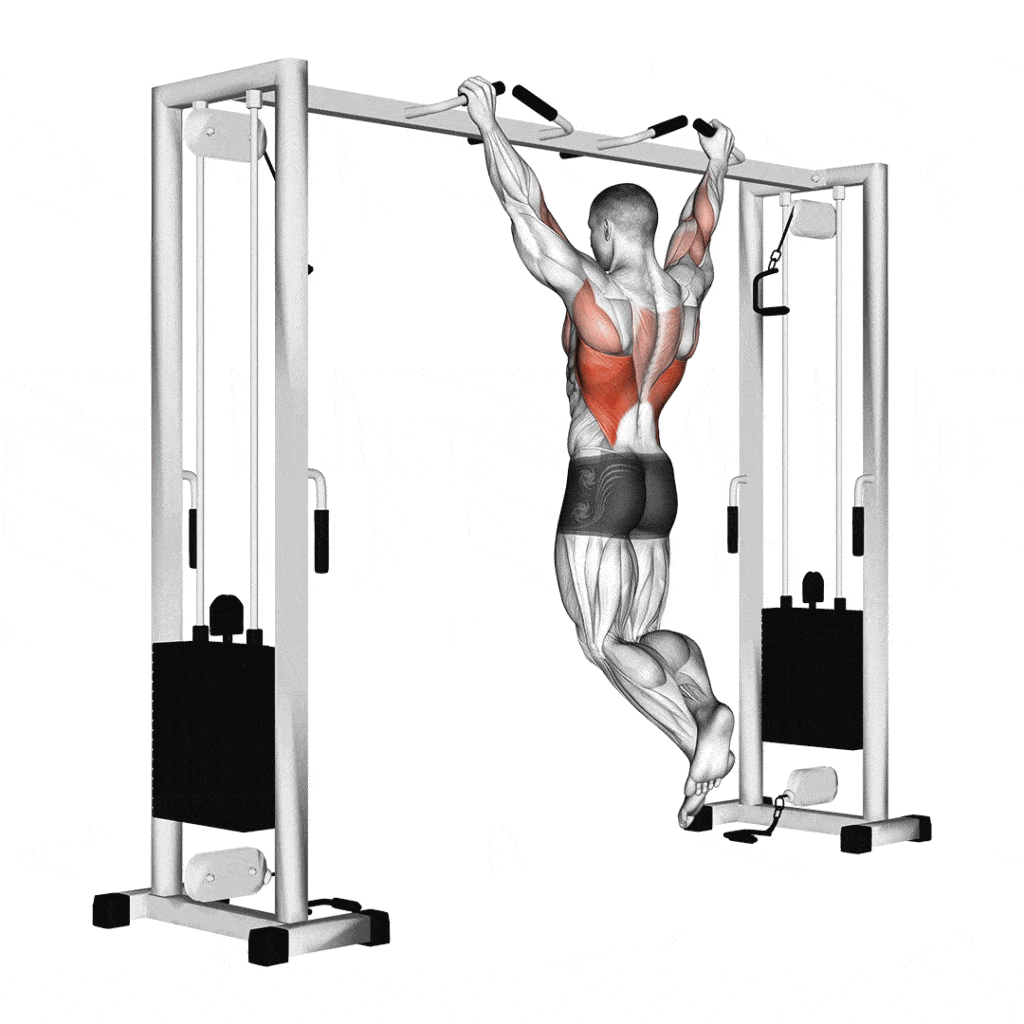
Description and Benefits:
Pull-ups are a challenging but effective upper body exercise. They target the latissimus dorsi primarily but also work the biceps, trapezius, and muscles in the shoulder and forearm. Pull-ups not only strengthen the back but also improve grip strength and enhance shoulder health.
Correct Form and Technique:
To perform a pull-up, start by grasping the pull-up bar with an overhand grip, hands slightly wider than shoulder-width apart. Hang with your arms fully extended. Pull yourself up until your chin is above the bar, squeezing your shoulder blades together. Lower yourself back down with control.
Common Mistakes to Avoid:
Common mistakes with pull-ups include using momentum or a ‘kipping’ motion to get above the bar, which can lead to shoulder injuries. Also, not achieving a full range of motion – not fully extending the arms at the bottom or not pulling up high enough – reduces the effectiveness of the exercise. Finally, make sure not to rush through the movement; focus on controlled, deliberate motions.
3. Seated Cable Row
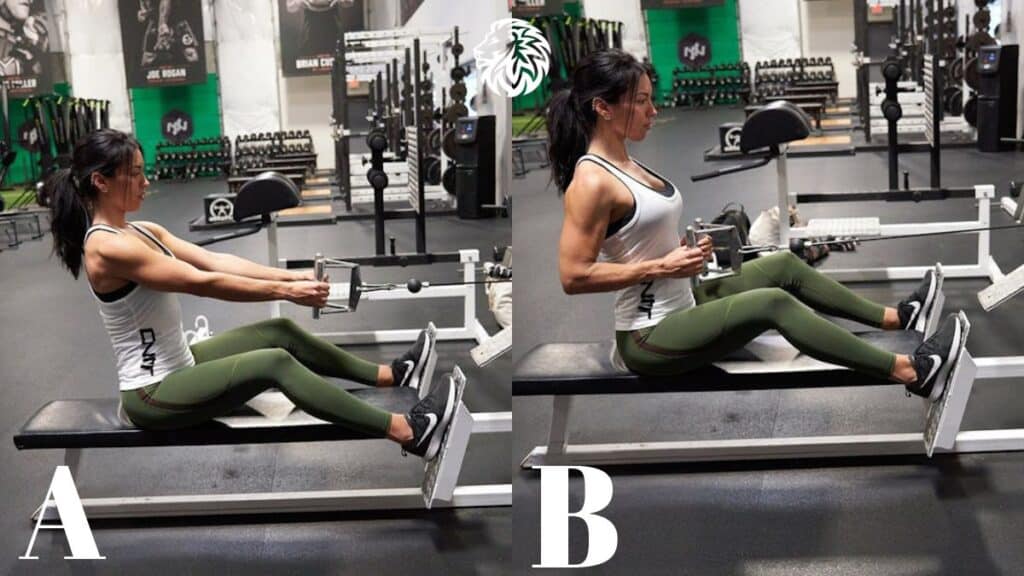
Description and Benefits:
The Seated Cable Row is an effective exercise that targets the muscles in the back, particularly the latissimus dorsi, rhomboids, and trapezius. It also works your biceps and forearms. Regularly performing this exercise can enhance back strength, improve posture, and aid in the prevention of back pain.
Correct Form and Technique:
To perform a seated cable row, sit at a cable row station with your feet on the footrests and knees slightly bent. Grasp the cable handle and sit upright, keeping your back straight. Pull the handle towards your abdomen while keeping your elbows close to your body and squeezing your shoulder blades together. Slowly extend your arms back out, maintaining control throughout the movement.
Common Mistakes to Avoid:
Common mistakes include leaning excessively forwards or backwards, which can strain the lower back. Additionally, pulling the handle too high or too low can reduce the effectiveness of the exercise. Always ensure you’re pulling towards your abdomen, not your chest or thighs.
4. T-Bar Row
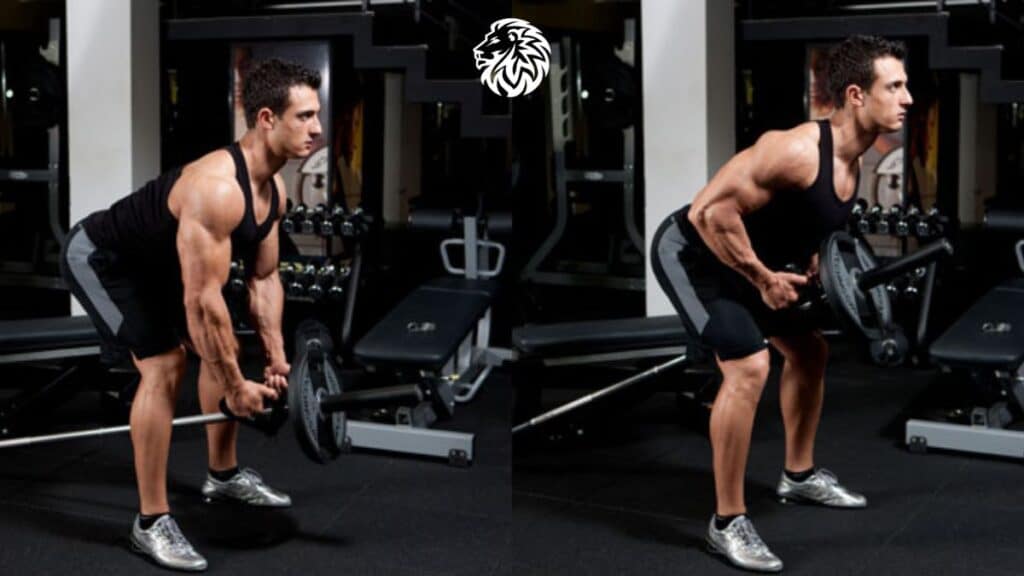
Description and Benefits:
The T-Bar Row is a compound exercise that targets numerous muscles in the back, including the latissimus dorsi, rhomboids, and trapezius. This exercise also engages the biceps, shoulders, and core, making it an excellent choice for overall upper body strength and stability.
Correct Form and Technique:
To perform a T-Bar Row, stand over the bar, and load one end with weight. Straddle the bar with your feet shoulder-width apart, knees slightly bent. Bend at the hips until your torso is about 45 degrees to the ground, keeping your back straight. Grasp the handles, and pull the bar towards your chest, keeping your elbows close to your body. Lower the bar with control.
Common Mistakes to Avoid:
Avoid rounding your back or lifting with your arms instead of your back, which can lead to injury. Also, avoid standing too upright as this shifts the emphasis away from the back muscles. Finally, avoid jerky or rapid movements; perform the exercise with smooth, controlled motions.
5. Lat Pulldown
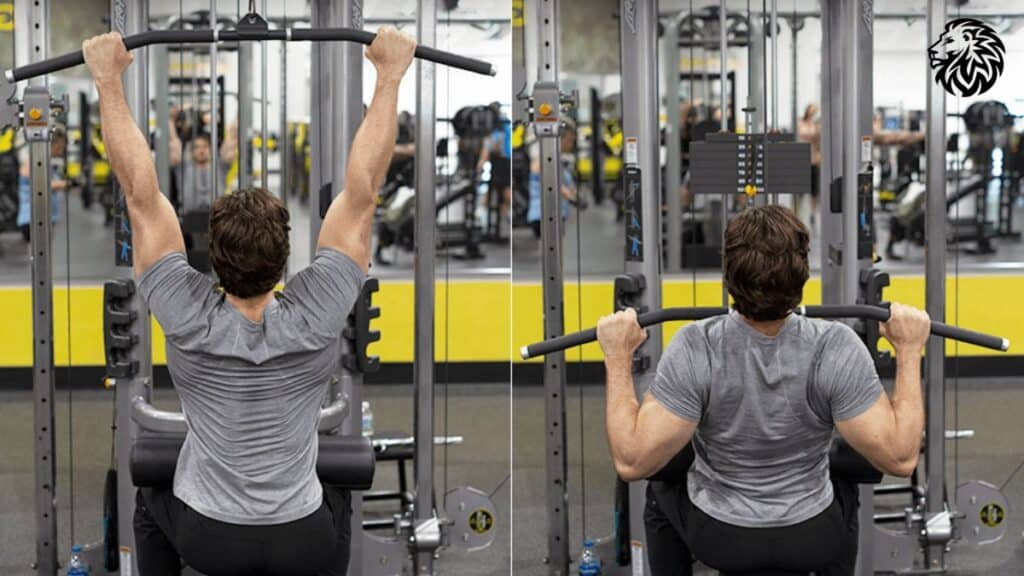
Description and Benefits:
The Lat Pulldown is an effective exercise that targets the latissimus dorsi, with secondary engagement of the biceps, rhomboids, and trapezius. Regularly performing this exercise can enhance back width and strength, improve posture, and aid in the performance of other exercises like pull-ups.
Correct Form and Technique:
To perform a lat pulldown, sit at a lat pulldown machine and grasp the bar with an overhand grip, hands slightly wider than shoulder-width apart. Keep your back straight and lean back slightly. Pull the bar down towards your chest, squeezing your shoulder blades together. Slowly extend your arms back up, maintaining control throughout the movement.
Common Mistakes to Avoid:
Common mistakes with lat pulldowns include pulling the bar behind the neck, which can strain the neck and shoulders, and using too much body momentum to pull down the bar, which reduces the effectiveness of the exercise. Also, avoid pulling the bar too low; aim for your upper chest. As always, ensure your movements are controlled and steady.
6. Hyperextensions
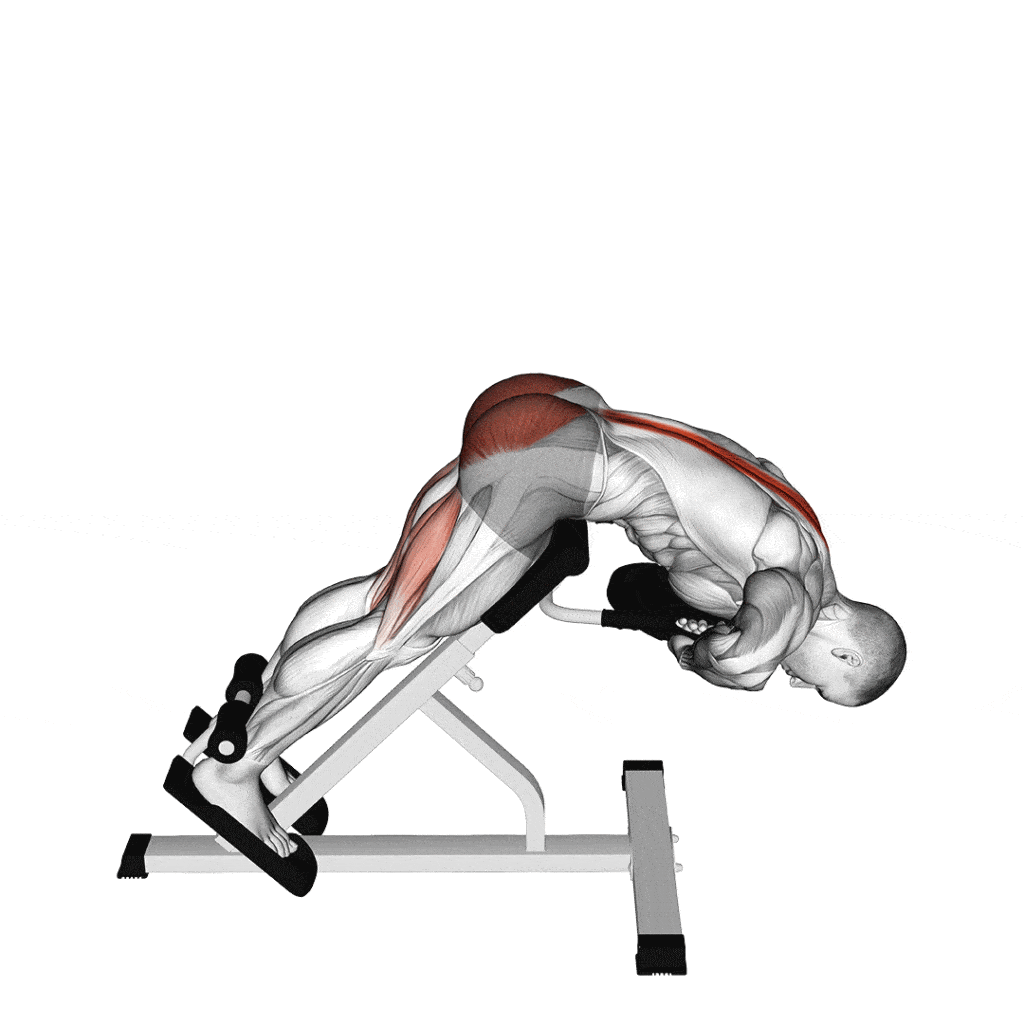
Description and Benefits:
Hyperextensions, or back extensions, are an effective exercise for strengthening the lower back, particularly the erector spinae. They also work the glutes and hamstrings. Regularly performing hyperextensions can help improve posture, alleviate lower back pain, and enhance overall back strength and stability.
Correct Form and Technique:
To perform hyperextensions, position yourself on a hyperextension bench with your ankles secured under the footpads and your waist aligned with the upper edge of the bench. Cross your arms over your chest (or place hands behind the head for a more advanced version). Lower your upper body down, maintaining a straight back. Raise your body back up by contracting your lower back and glute muscles, stopping when your body is in line with your legs. Control your movement throughout the exercise.
Common Mistakes to Avoid:
Common mistakes with hyperextensions include rounding or hyperextending the back, which can lead to injuries. Also, avoid using momentum to lift your body. Focus on using your lower back and glute muscles to perform the exercise.
7. Dumbbell Single Arm Row

Description and Benefits:
The Dumbbell Single Arm Row is a compound exercise that targets the latissimus dorsi and also works the rhomboids, trapezius, biceps, and muscles in the shoulders and lower back. This unilateral exercise can help improve muscular imbalances and enhance overall back strength and stability.
Correct Form and Technique:
To perform the Dumbbell Single Arm Row, place one knee and the same hand on a flat bench for support. Hold a dumbbell in your other hand with your palm facing inwards. Keep your back straight and pull the dumbbell upwards towards your chest, keeping your elbow close to your body. Lower the dumbbell slowly, maintaining control throughout the movement.
Common Mistakes to Avoid:
Avoid rounding your back or rotating your torso during the exercise, which can lead to injuries. Also, avoid pulling the dumbbell towards your shoulder instead of your chest, as this can reduce the effectiveness of the exercise. Always ensure your movements are controlled and steady, not rapid or jerky.
8. Deadlift

Description and Benefits:
The Deadlift is one of the most effective full-body exercises. While it heavily engages the posterior chain, including the lower back, glutes, and hamstrings, it also works the back, shoulders, and grip strength. Regularly performing deadlifts can improve overall strength, enhance posture, and boost athletic performance.
Correct Form and Technique:
To perform a deadlift, stand with your feet hip-width apart and your shins touching the barbell. Bend at the hips and knees to grasp the bar with an overhand or mixed grip. Keep your back straight, pull your shoulders back and look straight ahead. Stand up by straightening your hips and knees, lifting the barbell off the ground. Lower the barbell back down by bending at the hips and knees, maintaining control throughout the movement.
Common Mistakes to Avoid:
Common mistakes with deadlifts include rounding the back, which can lead to serious injury, and lifting with the arms instead of the legs and hips. It’s also important to avoid starting with your hips too low or too high, which can put unnecessary strain on the back or knees respectively. Always start with lighter weights to ensure correct form before progressing to heavier loads.
Tips for Incorporating These Exercises into Your Routine
Scheduling and Frequency Recommendations
Consider incorporating back exercises into your workout routine at least twice a week. This frequency allows your back muscles ample time to recover and rebuild between sessions. Choose the specific days based on your personal schedule, but try to spread them out evenly across the week for balanced training.
Order of Exercises for Optimal Results
When planning your workout, start with compound exercises like deadlifts and pull-ups that engage multiple muscle groups. These exercises require more energy and strength, making them ideal for the start of your workout. Then, move onto targeted exercises like seated cable rows or single arm dumbbell rows. Finish with lower intensity exercises such as hyperextensions to thoroughly work the entire back.
Combining Back Exercises with Other Workout Regimes
You can integrate back exercises with workouts for other muscle groups for a holistic strength-training routine. For example, you could pair back exercises with chest exercises on the same day for a balanced push-pull workout. Alternatively, you can create full-body workouts by blending back exercises with leg, arm, and core exercises.
Beginner or Health Condition-Specific Exercise Modification
If you’re a beginner or have specific health conditions, you might need to modify these exercises to match your capabilities. For example, beginners can start with assisted pull-ups or lat pulldowns before progressing to unassisted pull-ups. Light kettlebells or dumbbells can be used instead of a barbell for deadlifts. Always consult with a healthcare provider or fitness professional before starting a new exercise program if you have any health concerns.
Conclusion
Reiterate the key role that a strong back plays in overall physical health and well-being. A solid, well-conditioned back helps improve posture, enhance athletic performance, minimize the risk of injuries, and even alleviate chronic back pain. These benefits highlight why dedicating time and effort to strengthen your back is a worthy investment.
Encourage the reader to incorporate the eight outlined exercises into their fitness routine, regardless of their fitness level. Highlight that these exercises can be modified to match one’s fitness level and gradually increased in intensity as strength improves. Emphasize that consistency is key in witnessing tangible improvements.
Wrap up the article with motivating words to encourage consistency and perseverance in the reader’s fitness journey. Reiterate that progress might be slow, but with regular, targeted effort, they’ll likely see improvements over time. Encourage them to listen to their body, adjust workouts as necessary, and most importantly, enjoy the process of getting stronger. After all, fitness is a lifelong journey, not a destination.
Frequently Asked Questions
How can I ensure I’m performing these back exercises correctly and safely?
To perform these exercises safely, always start with a lighter weight to master the form and gradually increase as your strength improves. Each exercise should be performed in a controlled manner, without using momentum to move the weight. If possible, consider working with a trainer or a fitness professional initially to get personalized guidance.
I’m a beginner, can I still start with these back exercises?
Absolutely, these exercises can be modified to suit beginners. For instance, if you find pull-ups challenging, you can start with assisted pull-ups or lat pulldowns. As your strength improves, you can progress to more challenging versions.
Can I do these back exercises at home if I don’t have access to a gym?
Yes, many of these exercises can be modified to be performed at home with minimal equipment. For instance, dumbbell rows can be done with any heavy object at home, and pull-ups can be performed on any sturdy and safely installed bar at home.
How long before I see improvements in my back strength?
This largely depends on your starting point, the intensity of your workouts, and your consistency. Generally, you might start to see improvements in your strength and endurance within a few weeks. Remember, fitness is a journey and it’s important to focus on gradual progress over time.






